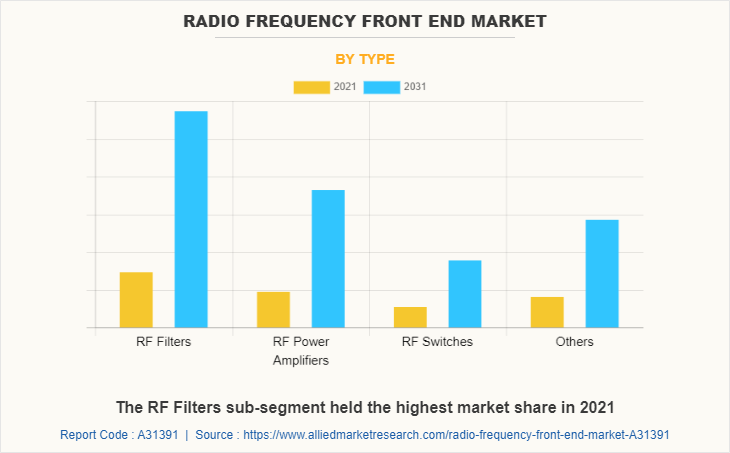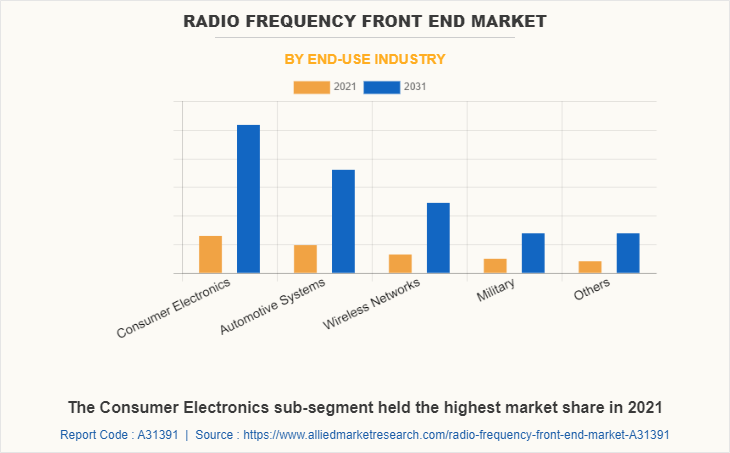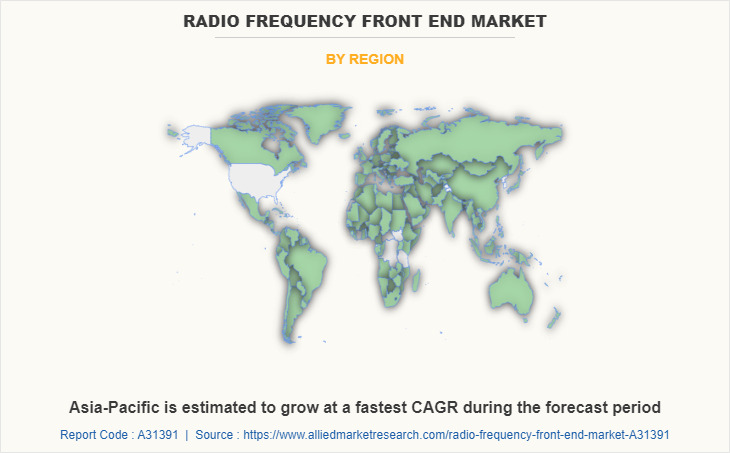Radio Frequency Front End Market Research, 2031
The global radio frequency front end market size was valued at $18.8 billion in 2021, and is projected to reach $69.9 billion by 2031, growing at a CAGR of 13.8% from 2022 to 2031.
A radio frequency (RF) front end module is a device panel that connects the antenna and receiver circuits. It is made up of an RF filter, an amplifier, a local oscillator, a mixer, and several switches. It is commonly used to reduce image response and keep out-of-band signals from oversaturating the input stages.

A rapid shift toward industrial automation, growing consumer preferences for smart devices, high R&D activities from major market players, are influencing the Radio Frequency (RF) Front End market. The advancement of technology toward silicon on insulator substrates such as silicon-germanium enables the integration of multiple RF components such as power amplifiers, low noise amplifiers, and others on the same chip. Furthermore, the rapid commercialization of 5G technologies, increasing use of wireless mobile communication devices, and high R&D activities of smartphones integrated with RF front-end modules can all propel market growth over time. Furthermore, an increase in data traffic, increasing adoption of Bluetooth-enabled devices, and rapid deployment of industrial IoT systems are some of the significant factors that are expected to transform the radio frequency front end industry outlook in the long run.
The market's main challenges are large investments in research and development. Other market challenges include technological innovation. Increases in RF complexity due to the increasing number of bands per mobile handset and the introduction of high-frequency brands are two major restraints. Other challenges include the large amount of space required for an RF antenna, which is not available in smartphones. These factors restrained the radio frequency front end market share during the analysis period.
Increasing demand in wireless networks is one of the major trends driving radio frequency front end market growth. The increasing use of mobile communication devices fuels the growth of the RF front end market. The increase in data traffic caused by data-intensive industries such as financial services is another key factor driving the growth of the market. Emerging carrier aggregation, which increases RF in tablets and smartphones, is another factor that is expected to accelerate market growth. Carrier aggregation is a popular concept in South Korea and is being implemented in countries such as the United States.
Segmentation Overview
The global radio frequency front end market is segmented on the basis of type, end user, and region. By type, the market is divided into RF filters, RF power amplifiers, RF switches, and others. By end-use industry, the market is classified into consumer electronics, automotive systems, wireless networks, military, and others. By region, the market is analyzed across North America, Europe, Asia-Pacific, and LAMEA.
By type, the RF filters sub-segment dominated the market in 2021. RF filters are electronic components that allow or prevent specific signals or frequencies from passing through in order to eliminate noise or pass through unwanted signals. These filters are frequently used as isolated components rather than incorporated into a system on chip (SoC) due to their propensity to provide improved selectivity with respect to high-frequency signals. These factors drive the RF filters sub-segment in radio frequency front end market opportunity.

By end user, the consumer electronics sub-segment dominated the global radio frequency front end market share in 2021. Any communication device needs radiofrequency components as a basic component in order to operate properly. The term "radiofrequency" describes radio waves with a frequency range of 3 kHz (1 kHz = 103 Hertz) to 300 GHz (1 GHz = 109 Hertz). The frequency range between 10 MHz and 10 GHz is of particular relevance in the realm of consumer electronics. Receivers/transmitters, filters, power amplifiers, duplexers, antenna switches, and demodulators are the key parts used in RF front communications in consumer electronics products. These factors drive the consumer electronics sub-segment in radio frequency front end industry.

By region, Asia-Pacific dominated the global market in 2021 and is projected to be the fastest-growing region during the forecast period. The demand for compact dual-band RF front-end modules for the satellite digital audio radio system (SDARS) operating in the S-band (2320-2345 MHz) and the L1-band (1574.42-1576.42 MHz) is anticipated to increase as the Asia-Pacific region's auto production ramps up. This might then help the local market grow. China is the world's largest producer of electric vehicles and is in the lead with regard to EV adoption during the projection period. All road transport modes combined, the share of EVs in new vehicle sales is predicted to reach 57% by 2030.

Competitive Analysis
The key players profiled in this radio frequency front end market forecast report include Broadcom Inc, Infineon Technologies AG., Murata Manufacturing Co. Ltd.., NXP Semiconductors N.V., Qorvo Inc.., Skyworks Solutions, Inc.., STMicroelectronics N.V., Taiyo Yuden Co., Murata Manufacturing Co., Ltd., and Analog Devices, Inc.
Key Benefits for Stakeholders
- This report provides a quantitative analysis of the market segments, current trends, estimations, and dynamics of the radio frequency front end market analysis from 2021 to 2031 to identify the prevailing radio frequency front end market opportunities.
- The market research is offered along with information related to key drivers, restraints, and opportunities.
- Porter's five forces analysis highlights the potency of buyers and suppliers to enable stakeholders to make profit-oriented business decisions and strengthen their supplier-buyer network.
- An in-depth analysis of the radio frequency front end market segmentation assists in determining the prevailing market opportunities.
- Major countries in each region are mapped according to their revenue contribution to the global market.
- Market player positioning facilitates benchmarking and provides a clear understanding of the present position of the market players.
- The report includes an analysis of the regional as well as global radio frequency front end market trends, key players, market segments, application areas, and market growth strategies.
Radio Frequency Front End Market Report Highlights
| Aspects | Details |
| Market Size By 2031 | USD 69.9 billion |
| Growth Rate | CAGR of 13.8% |
| Forecast period | 2021 - 2031 |
| Report Pages | 280 |
| By Type |
|
| By End-use Industry |
|
| By Region |
|
| Key Market Players | NXP Semiconductors N.V., Broadcom Inc., Murata Manufacturing Co., Ltd., Qorvo, Inc., Teradyne Inc., Texas Instruments Incorporated, Qualcomm Technologies, Inc., Skyworks Solutions, Inc., Infineon Technologies AG, STMicroelectronics |
Analyst Review
Rapid digitalization, along with growing industrial automation, particularly in developing economies, is one of the key factors driving the Radio Frequency Front End market's positive outlook. Furthermore, as social networking platforms and IoT devices become more popular, there is a significant increase in traffic generated by data-intensive industries such as banking, financial services, and insurance (BFSI). These factors are projected to boost the radio frequency front end market growth.
Biological effects caused by RF energy heating tissue are commonly referred to as "thermal" effects. For many years, it has been known that very high levels of RF radiation can be harmful due to the ability of RF energy to rapidly heat biological tissue. This factor may restrain the market growth.
Due to the growing use of mobile computing devices, network traffic is increasing at an exponential rate. The proliferation of mobile computing devices with increased capabilities (such as smartphones, tablets, and laptops) is driving internet bandwidth. The incorporation of advanced wireless technologies such as LTE and Wi-Fi has resulted in an increased demand for new RF functionalities in smartphones and tablets and is anticipated to generate opportunities in the upcoming years.
Among the analyzed regions, Asia-Pacific is expected to account for the highest revenue in the market by 2031, followed by Europe, North America, and LAMEA. The rise can be attributed to the increasing use of radio frequency components in consumer electronics. Power amplifiers and duplexers are being used in an increasing number of devices, including cell phones, tablets, laptops, and notebook computers. The radio frequency parts can be used to change the frequency. The radio frequency down converter converts the radio signal into a GSM baseband signal.
The diverse applications of radio frequency front end across consumer electronics, automotive systems, wireless networks, military, and other sectors are the major market drivers. In addition, the use of radio frequency front end in 5G to facilitate clean energy transition and to reduce the dependence on technology-based is estimated to generate excellent opportunities in the radio frequency front end market.
The major growth strategies adopted by radio frequency front end market players are product launch and merger & acquisition.
Asia-Pacific will provide more business opportunities for the global radio frequency front end market in the future.
Broadcom Inc, Infineon Technologies AG., Murata Manufacturing Co. Ltd.., NXP Semiconductors N.V., Qorvo Inc.., Skyworks Solutions, Inc.., STMicroelectronics N.V., Taiyo Yuden Co., Murata Manufacturing Co., Ltd., and Analog Devices, Inc. are the leading market players active in the radio frequency front end market.
The consumer electronic sub-segment of the end user acquired the maximum share of the global radio frequency front end market in 2021.
Technology industry leaders are the major the major customers in the global Radio frequency front end market.
The report provides an extensive qualitative and quantitative analysis of the current trends and future estimations of the global radio frequency front end market from 2021 to 2031 to determine the prevailing opportunities.
The use of radio frequency front end as an application in smartphone, and in the innovation new technology is estimated to drive the adoption of radio frequency front end.
Loading Table Of Content...



